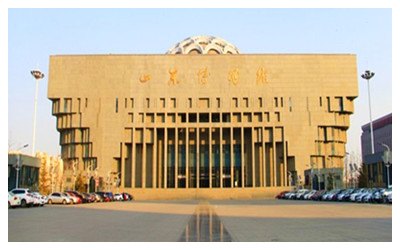
Shandong Provincial Museum was originally built in 1954, and it has been replaced by the new one on a large square in Jingshi Road, east of Yanshan Overpass. This was opened to the public on November 16, 2010. The new five-storey Shandong Provincial Museum has fifteen exhibitions halls where eleven permanent displays are on show. These include figure paintings from the Han Dynasty (202BC - 220AD), Buddhist sculpture, Shandong history and culture and a Confucian Culture exhibition. There is also a collection of calligraphy and paintings, Lu embroidery, fine porcelain articles, etc.
Shandong Provincial Museum, featuring some 100,000 historical relics, 8,000 specimens and a collection of 120,000 books, presents natural and historical treasures from the prehistoric Dawenkou and Longshan Cultures and the Qi Lu Culture. The latter having been the culmination of the cultural fusion of Qi and Lu states established by the Zhou Dynasty (1046 - 256BC) and lasting until the Qin and Han – Ming and Qing Dynasties.
After a security check, visitors follow the sign to enter the 3,000-square-meter (3,600 square yards) main lobby supported with eighteen big pillars. The dominant hue of the lobby is yellow, symbolizing the Yellow River which gave birth to the culture of Shandong and entire China.
Shandong History and Culture Display Area,
In the Shandong History and Culture Display Area, a bronze tomahawk with an inscription of the Shang Dynasty (1600 - 1046BC) is a treasure of Shandong Provincial Museum. The unique collection of pottery dating from the Dawenkou and Longshan cultural eras is the only one in the country. A gold belt fastener inlaid with 33 precious stones in various colors and a spectacular set of 397 wooden horse figures in a guard of honor is sure to catch your eyes.
In addition, for the first time there is a display of all the things unearthed from Zhu Tan (known also as Prince Lu, the 10th son of the first emperor of the Ming Dynasty (1368 - 1644AD) – Zhu Yuanzhang). A batch of precious cultural relics is also on show for the first time. This includes a standing Bodhisattva sculpture with a crown of cicada decoration and mural painting from Dongping Han Dynasty Tombs. The Bodhisattva sculpture was created 1,500 years ago, and now restored to China having been lost to overseas collections for fourteen years.
Note on Qi & Lu Culture
Shandong is also known as and called 'The Land of Qi Lu'. During the reign of the Zhou Wu Wang's son, the emperor vanquished the rebels of some kingdoms in present
Qufu, Boxing areas, Shandong Province. Then he conferred the title of marquis to two primary officials to govern this region, Qin Vassal State headquartered in today's Linzi (in Zibo City) and Lu Vassal State headquartered in today's Qufu. This was the eastern cultural center of Zhou.
During the Spring and Autumn Period, Confucianism came into being in the Lu State which was located east of Lu and adjacent to the ocean, where industry and commerce developed rapidly. Qi, close to the East China Sea, represents an open atmosphere, while Lu, close to
Mt. Taishan, shows relative conservatism promoting farming. Later in the Warring States Period, Mencius (the Lesser Sage as distinguished from Confucius the Sage) in Lu traveled to Qi twice for education and cultural exchange, and the fusion of the Qi and Lu cultures began.
Confucius Culture Exhibition
Confucius cannot be overlooked when referring to the Shandong culture. The Confucius Culture Exhibition showcases Confucius' life and his growth as a spiritual leader in a different way. There are works of art, costumes and daily necessities from the
Kong Family Mansion, cultural relics used for Confucius memorial ceremonies and multimedia display of thirty-six paintings illustrating Confucius' stories.
New techniques are employed to give a much more impressive experience for visitors. A visit to Shandong Provincial Museum is like a dialogue with history, revealing the wonders of Shandong.
Travel Tips
Add: in
Jingshi Road, east of Yanshan Overpass,
Jinan City
Opening Hours: 08:00-17:00 (closed on Monday)
Entrance Fees: CNY 0
 Shandong Provincial Museum was originally built in 1954, and it has been replaced by the new one on a large square in Jingshi Road, east of Yanshan Overpass. This was opened to the public on November 16, 2010. The new five-storey Shandong Provincial Museum has fifteen exhibitions halls where eleven permanent displays are on show. These include figure paintings from the Han Dynasty (202BC - 220AD), Buddhist sculpture, Shandong history and culture and a Confucian Culture exhibition. There is also a collection of calligraphy and paintings, Lu embroidery, fine porcelain articles, etc.
Shandong Provincial Museum was originally built in 1954, and it has been replaced by the new one on a large square in Jingshi Road, east of Yanshan Overpass. This was opened to the public on November 16, 2010. The new five-storey Shandong Provincial Museum has fifteen exhibitions halls where eleven permanent displays are on show. These include figure paintings from the Han Dynasty (202BC - 220AD), Buddhist sculpture, Shandong history and culture and a Confucian Culture exhibition. There is also a collection of calligraphy and paintings, Lu embroidery, fine porcelain articles, etc. Ask Questions ?
Ask Questions ?